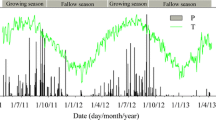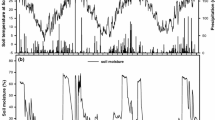Abstract
A greenhouse pot experiment was carried out to study the effect of land management during the winter crop season on methane (CH4) emissions during the following flooded and rice-growing period. Three land management patterns, including water management, cropping system, and rice straw application time were evaluated. Land management in the winter crop season significantly influenced CH4 fluxes during the following flooded and rice-growing period. Methane flux from plots planted to alfalfa (ALE) in the winter crop season was significantly higher than those obtained with treatments involving winter wheat (WWE) or dry fallow (DFE). Mean CH4 fluxes of treatments ALE, WWE, and DFE were 28.6, 4.7, and 4.1 mg CH4 m−2 h−1 in 1996 and 38.2, 5.6, and 3.2 mg CH4 m−2 h−1 in 1997, respectively. The corresponding values noted with continuously flooded fallow (FFE) treatment were 6.1 and 5.2 times higher than that of the dry fallow treatment in 1996 and 1997, respectively. Applying rice straw just before flooding the soil (DFL) significantly enhanced CH4 flux by 386% in 1996 and by 1,017% in 1997 compared with rice straw application before alfalfa seed sowing (DFE). Land management in the winter crop season also affected temporal variation patterns of CH4 fluxes and soil Eh after flooding. A great deal of CH4 was emitted to the atmosphere during the period from flooding to the early stage of the rice-growing season; and CH4 fluxes were still relatively high in the middle and late stages of the rice-growing period for treatments ALE, DFL, and FFE. However, for treatments DFE and WWE, almost no CH4 emission was observed until the middle stage, and CH4 fluxes in the middle and late stages of the rice-growing period were also very small. Soil Eh of treatments ALE and DFL decreased quickly to a low value suitable for CH4 production. Once Eh below −150 mV was established, the small changes in Eh did not correlate to changes in CH4 emissions. The soil Eh of treatments DFE and WWE did not decrease to a negative value until the middle stage of the rice-growing period, and it correlated significantly with the simultaneously measured CH4 fluxes during the flooded and rice-growing period.
Similar content being viewed by others
References
Cai ZC, Xu Hua, Lu WS & Wei CF (1998) Influence of water management in winter crop season on CH4 emission during rice-growing season. Chinese J Appl Ecol 9(2):171–175
Cai ZC (1995) Estimation of methane emission from Chinese rice fields. In: Chen Yiyu (ed) Study of Wetlands in China, Jilin Science Technology press. p 79–85
Cai ZC (1997) A category for estimate of CH4 emission from rice paddy fields in China. Nutr Cycling Agroecosyst 49:171–179
Cicerone RJ & Shetter JD (1981) Sources of atmospheric methane: measurements in rice paddies and a discussion. J Geophys Res 86:7203–7209
Crozier CR, Devai & Delaune RD (1995) Methane and reduced sulfur gas production by fresh and dried wetland soils. Soil Sci Soc Am J 59:277–284
Denier van der Gon HAC & Neue HU (1995) Influence of organic matter incorporation on the methane emission from a wetland rice field. Global Biogeochem Cycles 9:11–22
IPCC – Intergovernmental Panel on Climate Change (1992) Climate Change, the supplementary report to the IPCC scientific assessment. Cambridge (UK): Cambridge University Press. XII+200 p
IRRI – International Rice Research Institute (1991) World Rice Statistics 1990. Manila (Philippines)
Khalil MAK, Rasmussen RA, Wang MX & Ren L (1991) Methane emissions from rice fields in China. Environ Sci Technol 25:979–981
Masscheleyn PH, Delaune RD & Patrick Jr WH (1993) Methane and nitrous oxide emission from laboratory measurements of rice soil suspension: effect of soil oxidation-reduction status. Chemosphere 26:251–260
Sass RL, Fisher FM, Harcombe PA & Turner FT (1991) Methane production and emission in a Texas rice field. Global Bigeochem Cycles 4:47–68
Sass RL, Fisher FM, Wang YB, Turner FT & Jund MF (1992) Methane emission from rice fields: the effect of flood water management. Global Biogeochem Cycles 6:249–262
Schutz H, Seiler W & Conrad R (1989) Processes involved in formation and emission of methane of rice paddies. Biogeochemistry 7:33–53
Soil survey staff (1975) Soil Taxonomy. U. S. Dep. Agricultural Handbook. No. 436. Washington, D.C.
Trolldenier G (1995) Methanogenesis during rice growth as related to the water regime between crop seasons. Biol Fertil Soils 19:84–86
Wang ZP, Delaune RD, Masschelegn PH & Patrick Jr WH (1993) Soil redox and pH effects on methane production in flooded rice soils. Soil Sci Soc Am J 57:382–385
Wassmann R, Papen H & Rennenberg H (1993) Methane emission from rice paddies and possible mitigation strategies. Chemosphere 26:201–217
Yagi K & Minami K (1990) Effect of organic matter application on methane emission from some Japanese paddy fields. Soil Sci Plant Nutr 36:599–610
Yagi K, Tsuruta H, Minami K, Chairoj P & Cholitkul W (1994) Methane emission from Japanese and Thai paddy fields. In: Minami K, Mosier A & Sass R (eds) CH4 and N2O. Proceedings of an International Workshop; 25-26 March 1992; Tsukuba, Japan. p 41–53
Author information
Authors and Affiliations
Rights and permissions
About this article
Cite this article
Xu, H., Cai, Z., Jia, Z. et al. Effect of Land Management in Winter Crop Season on CH4 Emission During the Following Flooded and Rice-Growing Period. Nutrient Cycling in Agroecosystems 58, 327–332 (2000). https://doi.org/10.1023/A:1009823425806
Issue Date:
DOI: https://doi.org/10.1023/A:1009823425806




